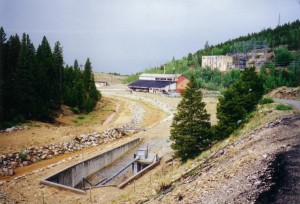by George Sibley
Here in the headwaters of the American West, in Central Colorado where many of our western rivers start, this is a good time to be thinking about what we call “fresh water.” That’s water that lacks most of the dissolved stuff found in the oceans – the essential waters that nurture all the plant and animal life on the planet we call “Earth.”
If our first look at the planet had been from out in space, we might have called the planet “Ocean” rather than “Earth”; there’s more than twice as much ocean as earth on the planet, and the planet’s capability for supporting our kind of life depends on its orbit at just the right distance from the sun for most of the planet’s water to be in its liquid form most of the time. On hot Venus, the next planet closer to the sun, all its water is in a permanent vaporous cloud (along with other elements, like poisonous mercury, that are liquid on earth). And on Mars, the next planet farther out, all the surface and atmospheric water lies in a solid state at the poles.
Life on this planet probably began in the oceans that cover 70 percent of the planet, and the oceans are still the source and home of most of the planet’s life. But once life began to move up onto the land, that life became dependent on the capacity of the oceans’ water to go to its vaporous state under the power of the sun, then condense as it rose as relatively pure water that fell back on earth and ocean. Most land-based life cannot live on water as saturated with dissolved solids as are the oceans. We need that “fresh water” the sun cooks out of the ocean.
What’s a little ominous about this is how little fresh water there really is. According to the U.S. Geological Survey, 97.5 percent of the water on the planet at any given time is in the oceans or other salt-water repositories (like the Great Salt Lake). Only 2.5 percent of the planet’s water is fresh enough for our use, and 69 percent of that is (or was until recently) sequestered in glaciers and ice sheets; another 30 percent is “non-tributary groundwater” – deep, slowly-accumulating aquifers that do not interact with surface waters.
That leaves a mere 1.2 percent as “surface water”: lakes, rivers and streams, and the soil moisture that interacts with surface water – and more than two-thirds of that is surface ice and permafrost in the high latitudes and altitudes. The remainder of that 1.2 percent is the rivers, lakes, swamps and alluvial groundwater that are the fundamental resource for all living things on the rock and earth parts of the planet. Remember that this vital 1.2 percent is not one percent of all the water on the planet; it is just 1.2 percent of the 2.5 percent that is fresh – three-hundredths of a percent of all the planet’s water. (More at the U.S.G.S. website, with some neat graphs: water.usgs.gov/edu/earthwherewater.html.)
We probably love the surface waters more than we understand them. We love to see them, play in and around them, seek challenges from them – fresh-water lakes, ponded sloughs, and especially those tumbling streams here in the headwaters, and the rivers the streams create, alternately roaring down canyons and meandering in valley floodplains.
We also love the presence of those same waters in our homes and yards at the turn of a faucet. We have practically been given cultural permission to show our appreciation for that mundane miracle by taking it for granted.
But there are a couple other considerations lurking under the beauty we see in our surface waters. In the short term of mere millennia, we can ignore the darker consequence of moving water. Much of the rugged alpine beauty we love here is a consequence of water’s persistent effort to convert everything solid on earth to silt, sand and gravel in a sea-level peneplain, as it did to the first set of Rocky Mountains. But we have had to deal with the cumulative salinity as the progressively less fresh water nibbles away at the land and its life, especially in the naturally alkaline western desertlands.
We should also think about the fact that water flowing over land represents the failure of the land and the life thereon to hold onto that essential three-hundredths of a percent of the planet’s water, soak it up, sink it in. Rivers don’t “water the land”; they are carrying water off the land – unless we or the beavers slow or stop it. Why shouldn’t the farmers and ranchers run it back out onto the floodplains and lower benches, giving it another chance to nurture earth life before disappearing back into the ocean? A mountain rancher told me once that it was every rancher’s dream to turn his “watershed” into a “catchment basin.” That might be a little too efficient. The water that drains out of the high meadows, despite the rancher’s efforts, flows down to lower meadows and fields where it gets used again and again – a kind of a collaborative reuse efficiency.
[InContentAdTwo]
Much is made today of the fact that the Colorado River no longer flows to the ocean most years. Why shouldn’t this be a cause for celebration, among the living? It means that we have managed to more fully employ, for earth life, one river’s portion of that three-hundredths of a percent. “Conservation” in Theodore Roosevelt’s time meant “conserving for human uses” the waste of burning forests and of water running off to the ocean unused in a two-month spring flood – hence the movement called “reclamation.”
True, so thoroughly employing the Colorado River has cost us a beautiful wild delta where the river emptied into the Sea of Cortez. But we’ve replaced that old delta with a vast new “desert delta” that begins in the Phoenix-Tucson corridor and spreads through the Gila River basin, the Imperial Valley, and on over the San Jacinto Mountains to the Los Angeles-San Diego metropolis. The river now fans out to all those places from Parker Dam and disappears into the desert rather than the ocean, nourishing a lot of life as it does. We do not appreciate this manmade desert delta the way we (or at least Aldo Leopold) appreciated the old delta where the Colorado disappeared into the ocean, but out of that new delta comes a big portion of the fresh food we now take for granted all winter, as well as a lot of the “mind-fodder” that passes for intellectual culture in America today.
Given the fact that we humans refuse to really limit our own population to what might be a comfortable fit with the most easily accessible and renewable three-hundredths of a percent of the planet’s water, we need to explore other strategies. For the time being, we are tapping into the deep aquifers that have been collecting minute bits of water for eons, but that is a form of mining that, like all mining, is not sustainable in the long run. However, the odds might favor the bet that the human population will collapse before the bottom of the Pleistocene aquifers are reached. We are experimenting with recharging some of those aquifers in big water years, but we aren’t sure that is going to work everywhere. We are trying to make our winter storms more efficient, seeding clouds to squeeze out all the precipitation possible.
Anthropogenic climate change might even help – somewhat significantly, in some places. The frozen polar regions are beginning to melt out, but the biggest ice sheets unfortunately pour right into the ocean. Water from melting glaciers can be caught and used but is hardly a long-term solution to anything. And melting permafrost (which also releases unfortunate quantities of methane) occurs mostly in regions unsuitable for growing either mass food or mass society. It does look, however, like less of the planet’s fresh water will be tied up in “frozen assets” in the foreseeable future; we may have ended the Pleistocene, the Ice Age – and good riddance. Talk about a waste of water.
Will the additional heat energy in the atmosphere cause significantly more pure water vapor to be sucked up from the oceans and moved over the land to condense and precipitate in significantly larger quantities? Or will most of it immediately fall back into the ocean? Will that additional heat energy expand the great cells of rising and falling wet and dry air, pushing the subtropical desert belt north into Central Colorado as well as California? Or will it just intensify the action within those cells (possibly bringing us more water, but at odd times, in extreme amounts)?
Nothing to do but stay tuned there, I guess, and maybe be a little more alert than usual. But we really might start rethinking the current romantic cultural belief that all rivers should run free, and start figuring out how we can best use, with the least taken-for-granted abuse, the precious little fresh water the planet has for all of us earthlings, animal and plant.
George Sibley’s writing may be explained as being watered from shallow alluvial wells in the Upper Gunnison River Valley.


